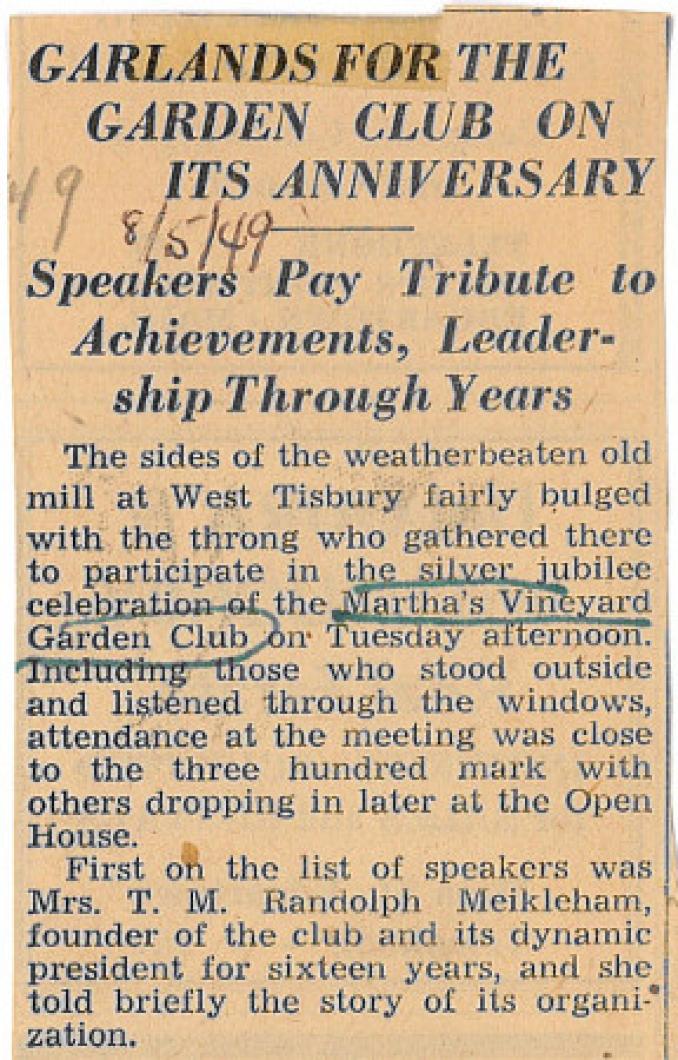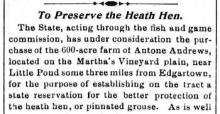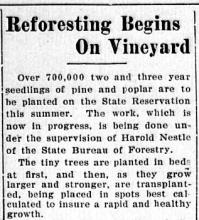The sides of the weatherbeaten old mill at West Tisbury fairly bulged with the throng who gathered there to participate in the silver jubilee celebration of the Martha’s Vineyard Garden Club on Tuesday afternoon. Including those who stood outside and listened through the windows, attendance at the meeting was close to the three hundred mark with others dropping in later at the Open House.
First on the list of speakers was Mrs. T. M. Randolph Meikleham, founder of the club and its dynamic president for sixteen years, and she told briefly the story of its organization
How It Started
“Enid Yandell came to me in 1924 and suggested I start a garden club in Edgartown,” Mrs. Meikleham recalled as soon as the rising ovation which greeted her appearance on the platform died down, “and I said I had no time, and besides, that I would not be interested in any garden club that did not represent the whole Island. So she said, ‘Well, then, let’s make it an Island thing’. That seemed to me a fine idea, with the proviso that the club be a constructive civic force and not just an excuse for pink teas and purple feathers. And I am glad to say that the conservation committee has always been the most active and important group in the club.”
Mrs. Meikleham referred specifically to the work of this committee cooperating with the state in tree maintenance. She also alluded to the absence of billboards as an outstanding achievement of the club, and in regard to this, she spoke of William G. Manter, whose response to her request to remove a billboard from the waterfront was at first bluntly refused, and then, on consideration, acceded to with the removal of five other signs. Mrs. Meikleham felt that Mr. Manter’s reaction typified the gradual realization by the Vineyard merchants of the real worth of a billboardless Island.
”What,” she concluded, “is the use of a beautiful thing, if is surrounded by ugliness?”
Rep. Joseph L. Sylvia, who followed Mrs. Meikleham, also spoke of the work done by the garden club to preserve the natural beauty of the Island, and mentioned especially the hedgerows along the up-Island roads which are receiving renewed attention, due to a special appropriation which Mr. Sylvia was able to obtain for the purpose. He also said that the interest stimulated by the garden club in the protection from exploitation of the stretch of beach along the Oak Bluffs-Edgartown road was in great part responsible for the state’s taking over the property.
“And now,” Mr. Sylvia said, “you need have no further fears that hot dog stands and unsightly shacks may be erected there. However, there are other spots on the Vineyard that are not free from such imminent danger. And that is why I feel so strongly that the garden club should exert its efforts and influence in putting over zoning ordinances in all of the Island towns.
“If the Island is to grow, and still maintain its essential characteristics of natural beauty, zoning is a necessity. Improved transportation is bound to bring development, but this development need not in turn bring ugliness if it is regulated. The ordnance may be a simple one, merely keeping business in its place, seeing that homes are not so crowded together as to take on a slum appearance, but have the space and air and light around them associated with old New England houses and, most important, preventing our road intersections from commercial encroachment which is both dangerous and an eyesore.
Zoning the Only Way
“The people of the Vineyard must come to realize that zoning is the only way to protect their way of living, that it is not regulation from the capitol, but an agreement mutually arrived at to protect their own interests and their Island. I look to the garden club to cooperate in making this realization manifest.”
The third speaker, and second president of the club, Mrs. Wilfrid 0. White, spoke of the double challenge that confronted her on taking office.
“Not only did I have the magnificent accomplishments of Mrs. Meikleham to live up to, but there was also imminent, and eventual, war, which for those sad and parlous times necessitated a deviation from club routine,” Mrs. White said. “I felt a little like my two grandchildren who were planning a private excursion one night, and after listing the various things they would need, one of them piped up, ‘I think, perhaps, we’d better take God along.’
“The work of the club for food conservation during the war is a matter of record although I believe the rat control project which was so enthusiastically underwritten by club members at its inception, was indeed outstanding as it has been a lasting thing. And the community gardens in Vineyard Haven were another constructive venture.”
Mrs. White related several amusing experiences she had in connection with both these projects and closed her talk with tributes to several indefatigable club members and others who had helped the club realize many of its plans, including Mrs. Meikleham, to whom she said she presented a “bouquet” of everlasting, as she would be forever remembered for her part in the history of the club, Mrs. Henry V. Greenough, Mr. Sylvia, Stephen C. Luce Jr., and Mr. and Mrs. Henry B. Hough of the Vineyard Gazette. She also paused a moment to recall the memory of those women who had worked so hard in the early days of the club and were no longer living.
Mr. Luce was introduced next, and he too spoke of the great success of the rat control program.
A Prime Exanple
“It is,” he stated, “a prime example of what can be done if gone at in the right way. It is effective, efficient and eminently worth while and for its adoption and success I want to give pretty nearly the whole credit to the garden club. I would also like to concur with Mrs. White on the real timely value of the community gardens.
“The work of the club toward maintaining the beauty of the roadsides was brought forcibly to my attention once again last week when my wife and I had occasion to ride up the North Road, and I recalled the interest of Mrs. Meikleham and her co-workers and their cooperation with the state Department of Public Works in the planting along this road when it was rebuilt.
“I would also, at this time, like to express the appreciation of the board of county commissioners for the enthusiasm and work of the club in the planting at the Indian burying ground and chapel in Christiantown. We have again allotted a sum to assist your committee in continuing its activities here. What you have already accomplished has added materially to the natural beauty of the site, and not only is the board indebted to you, but also the large number of people who travel up the dusty, winding road to the sanctuary for a moment’s communion with the past.”
It was to the past that Donald R. Campbell, the next speaker, confined his remarks — the past of the garden club centre, formerly the old satinet mill, which had been in his family for three generations.
Whaling Master Bought Mill
“My grandfather, Capt. Henry Cleveland, was a whaler,” Mr. Campbell related, “but he met with an accident and broke his leg, which ended his seafaring career. That was when he bought the mill from Thomas Bradley, who probably was sharp enough to realize that a small woolen mill such as this was no longer much of a business. My grandfather knew nothing about weaving, so he hired an Englishman named Howe to run the mill. Howe was a good weaver, but he was intemperate, to put it mildly, and frequently had to be loaded on to a wagon, stiff as a log, and carried home at night.
“He also must have been a tough man to work for, judging by the verse I remember was scribbled on one of the mill walls and ran ‘If anyone wishes to take up their cross, Just work in this mill with Howe for a boss’.
“My father, Thomas Campbell, was an Arctic whaling master, and he took the mill off grandfather’s hands before I was born. He never ran it, except for a few days in the fall when the neighbors would bring in their wool to be made into rolls, as they called it. I can just recall the last time it was run. I was about 5 years old. In 1891 a freshet tore out the sluiceway, and several years later my mother sold the machinery for junk.”
Mr. Campbell presented the club with one of the original reflector candle sconces used for light in the old mill, “In case,” he said with a grin, “you ladies might like to hold a night meeting some time”.
A tribute to the late Emma Mayhew Whiting, charter member of the garden club, was paid by Mrs. William M. Butler, who read several of Mrs. Whiting’s recently published poems, including Farm Woman’s Ballad and The Old Mill at West Tisbury.
“Mrs. Whiting knew the Island as no one else,” Mrs. Butler said, “and never did she attend a garden club meeting that she did not share some of this knowledge with our members. She knew our wild flowers, our shrubs, and even our weeds, and she knew the history of our old mill and its site. Although she cannot be with us today in person, her warmth and her humor and her great heart are ever present in this, her poetry.”
The concluding talk was by Henry Beetle Hough, who said that although this was the first time he had met the club face to face, he, and everyone else on the Vineyard, was constantly encountering it in the unspoiled countryside, with its vistas of fields and woods and sea, the hedgerows, the trees saved from destruction, and many other things that make up the beloved Island scene.
Not in the Hokinson Pattern
“Garden club meetings have long been the subject of gently malicious cartoons by Helen Hokinson, who has fixed them in the public mind as rather futile and faintly ridiculous affairs,” Mr. Hough said with a smile. “We of the Gazette, however, find it impossible to fit you, even a little, into the Hokinson pattern.
Your talks are solid, informational, and often pioneering, and the reports which we so gladly print at length in the Gazette, present helpful approaches to the problems of gardening, disease and insect control, conservation practices, and that background which is the stock in trade for anyone who likes to know and enjoy the seasons, the earth, and the life the earth supports.
“Another thing in which the garden club and the Gazette have worked in the past, and we hope may continue in the future, is the matter of public education and persuasion in civic affairs. For real effectiveness in such work, we need an organized opinion which has force, coherence, and conviction. And, within the realm of such things as the preservation of natural beauty and resources of the Vineyard, and resistance to encroachments, the Martha’s Vineyard Garden Club has represented just this organization.
“It has been willing to stand on principle time and again, and often its influence has been the deciding factor in an issue. It is a constructive community force without prejudice and without fear. And I can think of no better wish than that this same stewardship of the Island’s spirit and gardenlike qualities be exercised in the years to come.”
Musical selections were played at the beginning and middle of the program and during the refreshment hour, by Miss Barbara Barstow, violinist, and Miss Shirley Adams, cellist, of the Oklahoma Symphony Orchestra, and consisted of Handel’s Passacaglia arranged by Halvorsen, Orientale by Cesar Cue, and Etude by R. Gliere.
Special Anniversary Guests
Special anniversary guests of the club were Mrs. Robert Ferguson, president of the New Bedford Garden Club, Mrs. Pemberton Nye, a former president, Mrs. A. George Gigger, president of the Falmouth Garden Club, and Mrs. Milford Lawrence of Falmouth, whose husband spoke at the first meeting of the Martha’s Vineyard Garden Club in July. A most gratefully received anniversary gift of real sentimental value to the club was that of a piece of satinet made in the mill, presented by Mrs. Horace W. Athearn.
Fourteen shadow boxes featured arrangements of white flowers in silver containers, and despite the drought, showed variety and originality. Several of these were dish arrangements: one, by Mrs. Henry R. Anderson, was a formal symmettrical of white gladioli with self foliage against emerald green velvet; another, by Miss Lucy Wiig, used anchusa, asters and petunias; a third, by Mrs. James Morrice, was effective with artemesia, silver king, phlox and giant variegated caladium leaves; and a fourth by Mrs. Benjamin C. Mayhew; consisted entirely of Queen Anne’s lace, with foliage of variegated upright euonymous.
Mrs. Robert N. Elwell used a square dish for her bouquet of scabiosa, snapdragon and asters, and Mrs. Raymond Barth set off a round bonbon dish with a dainty arrangement of gladioli and sweet peas and background of blue metallic paper. An heirloom beverage pitcher contained Mrs. Alpheus M. Krantz’s buxom bouquet of nicotiana, cosmos, zinnias and phlox, and Miss Amy Ferris also did a buxom of phlox, Queen Anne’s lace, artemesia and dusty miller with caladium leaves for accent. There was a slender silver basket with simple cool sprays of cosmos by Mrs. Doris Sherwood, and a cake basket holding an arresting arrangement of pokeberry, dusty miller and petunias, with a bunch of green grapes for focus, this by Mrs. Charles Mahler.
Victorian Sugar Bowl
Mrs. Raymond Fuller had zinnias hosta seedpods and bullbrier in her Chinese bowl, and Mrs. Edmund Billings used dahlias and snapdragon accented by English ivy in a setting for console. A Victorian sugar bowl held Mrs. George E. Martin’s bouquet of petunias, asters, gooseneck and baby’s breath, and an arrangement of spike and leafy foliage with gladioli for interest in a silver tureen, was Mrs. Wilfrid 0. White’s tribute, In Memoriam, to club members who had died.
General chairman for the meeting and for the anniversary program book was Mrs. Benjamin C. Mayhew, and serving with her as chairmen of committees were Miss Priscilla C. Hand, hostesses and decoration; Mrs. William Ross Leigh, refreshments; and Mrs. Henry R. Anderson, flower boxes. Mrs. Sidney N. Riggs made the arrangements of foliage for the front of the hall.











Comments